Nvidia and AMD are again rolling out another generation of professional GPUs into the market in near lockstep. Nvidia’s latest Ada Generation GPU has led to two ultra-high-end products for fixed/deskside workstations: the RTX 5000 Ada and RTX 6000 Ada GPUs (not to mention GPU modules for mobile workstations). AMD countered with the Radeon Pro W7900 and W7800. Selling for $2,000-plus, all four offerings are too rich for most workstation users. Now, the companies are competing in the more lucrative $1,000 range in another head-to-head matchup with next-gen GPUs—Nvidia with its RTX 4000 Ada Generation, and AMD with its Radeon Pro W7700.
What do we think? While the products are comparable, once in the market, the vendors’ respective wares are not experiencing the same success, and the difference is stark. Today, Nvidia’s add-in GPUs selling into fixed workstations command approximately 97% of the units sold, and that number is even higher in the context of mobile GPUs serving the burgeoning mobile workstation market.
Disrupting that market status quo would require Nvidia to stumble or AMD to execute flawlessly. And while AMD’s execution isn’t flawless (whose is?), the company is hardly dropping the ball either. Rather, AMD’s problem is that Nvidia hasn’t provided any meaningful missteps of late for AMD to capitalize on. As a result, with this next pair of competing products serving the same (roughly) $1,000 ASP neighborhood, we see some familiar mix of results in benchmarking. Nvidia’s 3D graphics performance beats out AMD’s, but not by much (though that’s arguable if the same can be said about rendering), while AMD’s friendlier pricing allows its price-performance to similarly edge Nvidia.
Were the Radeon Pro W7700 able to set itself apart substantially in performance or price-performance, the dual-slot vs. single-slot issue wouldn’t be a significant one. And for many, it might still be a “don’t care.” But if the two are on par or close in other respects—and given the market today largely treats Nvidia as the default brand—the fact that the W7700 is thicker, may require more watts, and may displace a slot (depending on the motherboard), then it’s not going to help the Radeon Pro W7700’s prospects.
While this round of refreshes isn’t likely to significantly move the market share needle, that’s likely not of concern if you’re a user simply looking to configure a new workstation. Toward the top end of the market, maximum performance is more likely the critical purchase criterion, while at the bottom, price will stand out. In the $1,000 level these latest GPUs address, price-performance plays a more significant role. As such, AMD’s price-performance may pique the interest of users, while the bulk of buyers will continue to choose the 4000-series RTX Ada, a prospect made even more likely by its broader accessibility among workstation vendors’ configuration options. The bottom line for the professional buyer? There seems no clear right or wrong answer, and users of all stripes stand to benefit from compelling generation-to-generation performance gains from both vendors.
Nvidia vs. AMD: The battleground has moved to the $1,000 range
It does surprise me how consistently the GPU dyad of Nvidia and AMD executes on silicon development and subsequent product rollouts. Maybe it shouldn’t, and instead maybe it’s a pattern that should simply impress. Because when I stop to consider the massive undertaking that is the production of modern GPU (or CPU, for that matter), the fact that both vendors rarely stumble in execution—or at least not in any significant fashion—it should impress. No, their respective wares are not always on equal footing, but it’s rare to see one catch the other completely off guard with some dramatic generational advancement without a timely and commensurate response coming from the other.
So it has been in the market for professional-caliber discrete GPUs that outfit modern fixed and mobile workstations. New microarchitectural generations from both tend to appear in close proximity, as evidenced by the ongoing rollout of Nvidia’s Ada and AMD’s RDNA 3 generations. Both generations have already appeared in their respective workstation-focused RTX and Radeon Pro lines, starting primarily from the top and working their way down the price spectrum.
Over the past several months, Nvidia’s latest Ada Generation GPU had already spawned two ultra-high-end products for fixed/deskside workstations—the RTX 5000 Ada and RTX 6000 Ada GPUs—as well as a slew of GPU modules for mobile workstations. Meanwhile, AMD countered with two of its own lofty-priced options, the Radeon Pro W7900 and W7800. All four come with retail price tags in excess of $2,000, putting them beyond the reach of the majority of workstation users. But their appearance foreshadowed the next likely price point the two would serve with next-generation products: the lucrative $1,000 range. Sure enough, both delivered on that expectation, the former with the RTX 4000 Ada Generation, now matched up against the latter’s Radeon Pro W7700.
The RTX 4000 Ada Generation
A scan of the RTX 4000 Ada Generation’s salient hardware metrics show that its resource counts—most notably CUDA cores, Tensor cores, and RT cores—are essentially the same as its predecessor, the Ampere-generation RTX A4000. As such, the bulk of any RTX 4000 improvement in performance will be due to architectural enhancement and/or higher frequency execution. One notable exception is peak memory bandwidth, which actually decreases. Increasing power efficiency is the likely motivation behind the design choice, as power saved on the external interface can be spent elsewhere (e.g., clocks). But it’s also a testament to Ada’s architectural efficiency (and onboard cache) that it can achieve higher levels of performance with less total bandwidth at its disposal.
| GPU | RTX A4000 | RTX 4000 Ada Generation | RTX 5000 Ada Generation |
| Architecture | Ampere | Ada | |
| CUDA parallel processing cores | 6,144 | 6,144 | 12,800 |
| Tensor cores | 192 | 192 (4th gen) | 400 (4th gen) |
| RT cores | 48 | 48 (3rd gen) | 100 (3rd gen) |
| GPU memory | 16GB | 20GB GDDR6 with ECC | 32GB GDDR6 with ECC |
| Memory bandwidth (peak) | 448GB/s | 360GB/s | 576GB/s |
| Max power consumption (sustained) | 140W | 130W | 250W |
| I/O interface | PCI Express 4.0 x16 | ||
| Display connectors | DP 1.4a (4) | ||
| Form factor | Single slot | Dual slot | |
| Estimated ASP (retail-sampled 12/23) | $1,030 | $1,515 | $2,250 |
Table 1: Salient hardware metrics for RTX 4000 Ada Generation GPU, its bigger brother RTX 5000 Ada, and its predecessor, the RTX A4000. (Source: Nvidia)
Radeon Pro 7700
Long expected and first announced for workstation deployment in April 2023 is AMD’s RDNA 3 generation for Radeon Pro, initially consisting of two SKUs, the Radeon Pro W7800 and W7900. Both were, like Nvidia’s first Ada Generation RTX 6000 and RTX 5000, very pricey, at around $2,500 and $4,000 retail, respectively. But again, like Nvidia, AMD took the next step down the price curve more recently, with the W7700 selling for right around $1,000.
RDNA 3’s advancements track along with Ada as well, pushing resources—and commensurate performance—along the same general axes: faster Stream Processors for general-purpose computing and 3D graphics, improved (2nd-gen) RT Accelerator to speed path tracing for rendering, and AI accelerators tuned for machine learning (training and inference).
| GPU | Radeon Pro W7700 |
| Architecture | RDNA 3 |
| Computation Units (CUs) with ray accelerators | 48 |
| AI accelerators | 96 |
| GPU memory | 16GB GDDR6 with ECC |
| Memory bandwidth (peak) | |
| Total board power | 190W |
| I/O interface | PCIe 4.0 x16 |
| Display connectors | DP 2.1 |
| Form factor | Dual slot |
| ASP (retail-sampled 12/23) | $1,000 |
Table 2: Salient hardware metrics for the RDNA 3-generation Radeon Pro W7700. (Source: AMD)
RDNA 3’s Radiance Display Engine is one resource that sets RDNA 3 apart, supporting the newer, higher-bandwidth DisplayPort 2.1 vs. RTX’s DP 1.4a. At the physical layer, DP 2.1 more than doubles bandwidth, translating to higher resolution, higher refresh rates, more displays—or some combination of the three. It also allows for the option of 12-bit HDR color (4:4:4) with no chroma subsampling for the most visually precise demands.
However, there’s another aspect to the W7700 that sets it apart from the RTX 4000, and it’s obvious at a glance: The latter is a single-width PCI Express card, while the former is double-width. The form factor choices reflect the respective thermal and supply power specifications—130W for the RTX 4000 Ada and 190W for the Radeon Pro W7700. Of course, both use a single PCIe x16 slot, but the double-width card takes up more space and may block a second PCIe slot, depending on the motherboard and chassis. Most mini or full-size tower workstations will support a double-width card (along with the higher power requirement). Interestingly, it’s precisely this $1K-ish, 150W-ish point—the only point—in the GPU spectrum where we see this form factor disparity. Above this level, both vendors’ products are double-width, and below it, they’re all single-width.

RTX 5000 Ada drives up visual computing performance for 3D graphics and 3D rendering
When it comes to more traditional, interactive 3D graphics, SPECviewperf (in the latest 2020 version) remains the go-to benchmark for CAD and other applications heavy in professional visual processing workloads. Testing with SPECviewperf 2020 yielded the following results, run on the same high-performance system, swapping in the RTX 4000 Ada Generation, previous Ampere-generation RTX A4000, and the AMD Radeon Pro W7700.
The RTX 5000 Ada Generation GPU ran through the SPECviewperf 2020 viewsets on average 56% faster than the RTX A5000 (with the A6000 Ada Generation about 73% higher).
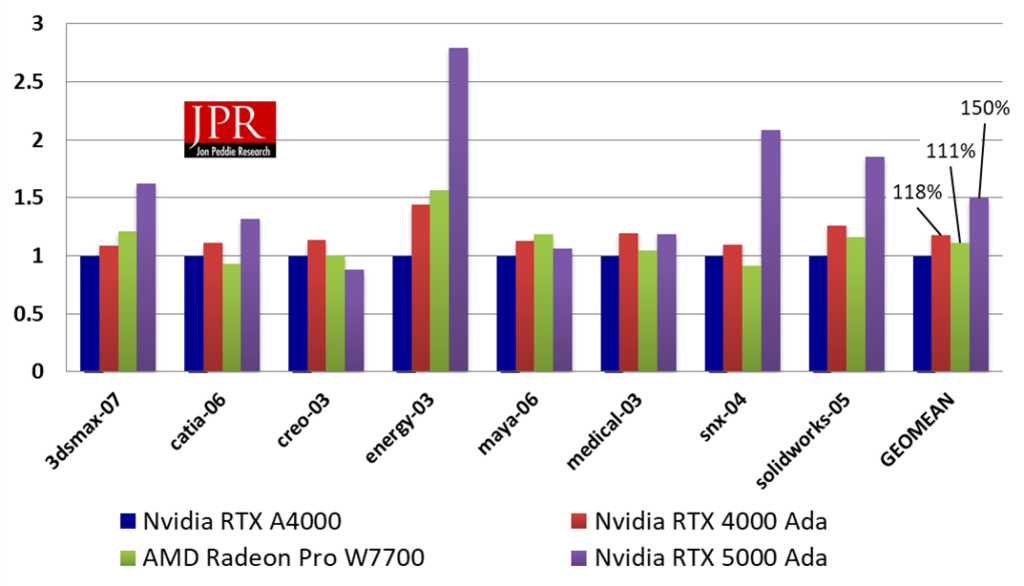
The script is flipped, however, when we look at price-performance, as the AMD Radeon Pro W7700’s somewhat more accessible ASP gives it the edge over the Nvidia RTX 4000 Ada.
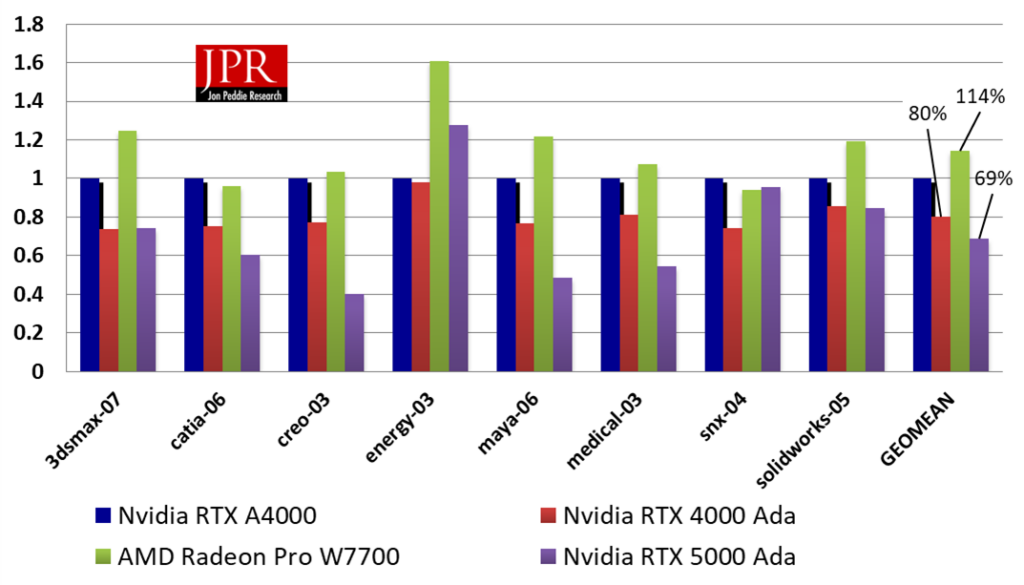
Finally, there’s the perspective of power efficiency, albeit a lesser issue (for most) in the context of fixed/wired workstations. Ranking instead scores per watt, the RTX 4000 Ada’s lower maximum sustained power draw puts its performance per watt out front of all comparable GPUs contrasted here. Bear in mind, these results don’t reflect the actual power consumed to achieve the corresponding score, but rather the sustained power limit the board can consume to ensure thermal and electrical tolerance.
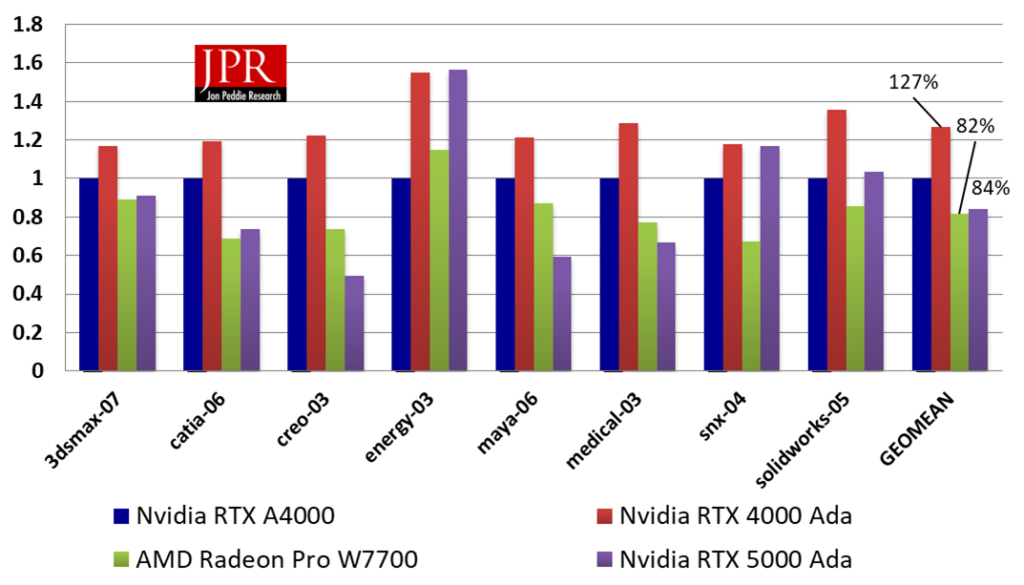
Rendering: GPU visual processing isn’t limited to 3D graphics
While still the foundation of most visual computing workflows, 3D graphics is no longer the only GPU function to assess. With the advent of on-chip ray-tracing hardware, along with the GPU’s ever-improving aptitude in general-purpose computation and machine learning, there’s more value to be exploited in a next-generation GPU.
Once a luxury, rendering has gotten progressively more accessible in workstation markets, thanks to pervasive application support, faster CPUs, and, specifically in the context of this review, GPU acceleration and supporting software libraries. Besides simply offering more CUDA, RT, and Tensor cores than the comparable previous-generation Ampere chips, Nvidia amped up the performance and functionality of each core when moving to Ada (with fourth-generation Tensor core and third-generation RT core architectures). For example, the RT cores themselves have been upgraded to provide an Nvidia-claimed 2×–3× increase in ray-tracing throughput over Ampere. And while 3D graphics processing primarily leans only on the CUDA cores, it’s rendering that represents a crossroads of algorithms that leverage capabilities of all three cores.
Consider DLSS 3, which extends on the AI/rendering synergies previously exploited in Ampere and Turing DLSS and DLSS 2 (Ampere’s predecessor). The preceding algorithms leveraged machine learning to intelligently fill in pixels or rays (which correlate in number to viewport pixels at rendering), thereby cutting the time required to arrive at the final rendered image. In Ada, DLSS 3 takes that to a logical next step, but in the temporal rather than spatial domain. Rather than filling in pixels or rays within the same frame, DLSS 3 allows for trained neural networks to create intermediate frames, thereby increasing frame rate with, again, much less brute-force visual processing.
Results from testing both the RTX 4000 Ada Generation and previous-gen RTX A4000 provide ample evidence of Ada’s advanced aptitude across all processing cores, with the former outperforming the latter by 41% (geomean of three scene scores) on the Blender Cycles benchmark, a margin even higher than that of SPECviewperf 2020’s 3D graphics.
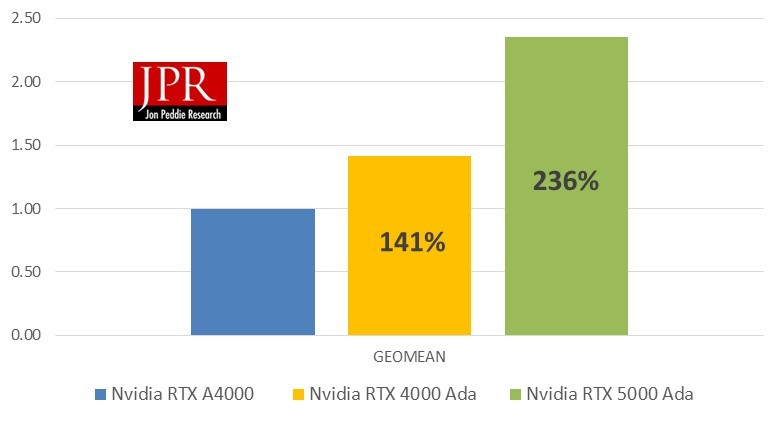
With the availability of Maxon’s Cinebench 2024, I’ve finally found a fair basis to compare Nvidia and AMD GPU-accelerated rendering. Prior generations of Cinebench or other benchmarks like Blender Cycles or LuxRender, would put either Nvidia or AMD at a disadvantage, without embedded support for the vendor’s preferred optimized library: Nvidia’s CUDA or AMD’s more recent HIP RT. Cinebench 2024, on the other hand, now supports both, with testing showing the RTX 4000 Ada outperforming its predecessor, RTX A4000, by 41%, while the Radeon Pro W7700 achieved about 85% of the latter’s frame rate.
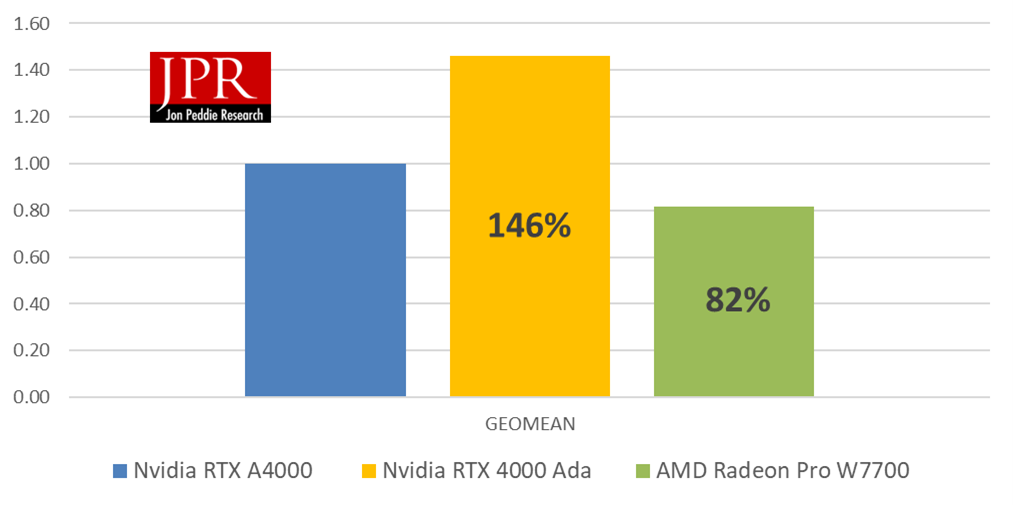
While visual processing—primarily 3D graphics but increasingly rendering—remains the bulk of the professional GPU’s workloads, accelerating other computation has broadened its utility. Dominating mindshare today is AI, with the GPU generally viewed as the preferred engine for both training and inference. SPECworkstation’s GPU Compute test suite provides some level of insight into how well a GPU can benefit deep learning (with Caffe) and scientific research (with FAH, or Folding@home), as well as another providing an additional rendering data point with LuxRender.
Running SPECworkstation 3.1 on the same test system, Nvidia’s RTX 4000 Ada Generation outperformed its predecessor, the RTX A4000, by 20% on the GPU Compute test suite. Bear in mind that in absolute terms, Nvidia GPUs’ performance on the GPU-specific tests won’t be optimal, as these test support OpenCL, not Nvidia’s own CUDA acceleration library. However, viewed generation-to-generation, scores should provide another suitable reference indicating Ada’s performance advancement over Ampere.
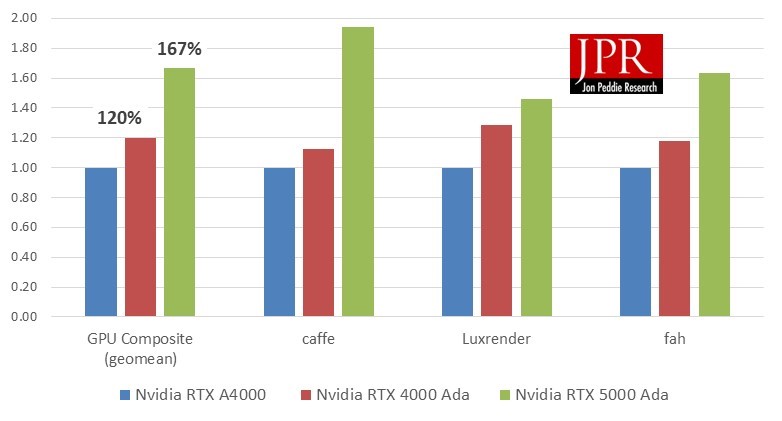
An in-depth look at the workstation market can be found in the JPR Workstation Professional Computing Markets and Technologies report series.